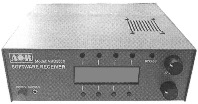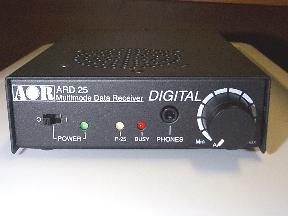|
|
|
Radio Shack is selling the handheld PRO-18 as a cheaper alternative to
the PSR-800.
This scanner is designed to run from data loaded onto a memory card, avoiding keypad-style programming. It is capable of tracking APCO Project 25, Motorola, EDACS and LTR trunked systems.
This scanner lacks the following features that are availabile on the PSR-800:
Upgrades Check the Radio Shack website here for firmware updates as well as an Owner's Manual in electronic format.
|
|
Radio Shack is selling the handheld PRO-106 and base/mobile PRO-197 scanners.
They are nearly identical to the GRE PSR-500 and PSR-600 scanners, respectively.
These scanners are also capable of tracking Motorola, EDACS and LTR trunked systems.
Upgrades Check the Radio Shack website here for firmware updates as well as an Owner's Manual in electronic format. July 2009: Radio shack has released the CPU 1.7 firmware upgrade for the Pro 106 and Pro 197. New features:
|
|
GRE is selling the handheld PSR-500 and base/mobile PSR-600 scanners.
Upgrades Check the GRE America website here for firmware updates as well as an Owner's Manual in electronic format.
|
|
Icom is selling the PCR-2500, a "black box" computer-controlled receiver.
With the optional UT-112 P25 Digital Voice Decoder, the PCR-2500 is
able to decode (but not track) APCO Project 25 transmissions.
The PCR-2500 is not able to track any type of trunked radio system.
Upgrades Check the Uniden website here for firmware updates as well as an Owner's Manual in electronic format.
|
|
Uniden is selling their BCD996T, a base or mobile scanner
capable of monitoring mixed and all-digital APCO-25 systems
as well as analog Motorola, EDACS and LTR systems.
The BCD996T also accepts NMEA-formatted GPS information and automatically selects appropriate frequencies to scan based on location.
Upgrades Check the Uniden website here for firmware updates as well as an Owner's Manual in electronic format.
|
|
Uniden is selling their BCD396T, a compact handheld scanner
capable of monitoring mixed and all-digital APCO-25 systems
as well as analog Motorola, EDACS and LTR systems.
The BCD396T also offers the "Close Call" feature, allowing the scanner to automatically tune to nearby radio transmissions. Initial shortcomings appear to be manual adjustment of voice quality on APCO-25 systems.
You can read a detailed review of the BCD396T, with several photographs, from a user in the United Kingdom here. Upgrades Check the Uniden website here for firmware updates as well as an Owner's Manual in electronic format.
|
 Radio Shack is selling the PRO-96, a GRE-built scanner
capable of monitoring 3600-baud and 9600-baud trunked APCO-25
systems.
Radio Shack is selling the PRO-96, a GRE-built scanner
capable of monitoring 3600-baud and 9600-baud trunked APCO-25
systems.
The PRO-96 features "V-Scanner" consisting of a number of preloaded frequencies and talkgroups for major metropolitan areas in the United States. Shortcomings include lack of LTR tracking and a relatively short battery life.
Upgrades
Version 1.3 CPU
You can bring your scanner into your local Radio Shack store and have them send it in for the upgrade. Most clerks will not be aware of the process they need to follow. The scanner must be sent to the Fort Worth service center (04-0804), since it is the only facility equipped to do this particular upgrade. You should also make note of your scanner's serial number to be sure you can track the repair progress and confirm that you get your own scanner back. (There have been stories about difficulties in the upgrade process, and of customers getting the wrong scanner back.) It was also reported that there are delays in the upgrade process after the facility ran out of replacement CPUs some time in September. Although more are (were) expected from overseas, there may be a substantial backlog that must be worked through.
Version 1.2 DSP
You can read more about the PRO-96 here.
|
|
Uniden is selling upgraded digital scanners, the
BC296D handheld and the BC796D base/mobile scanners.
Each of these scanners is capable of monitoring APCO-25 systems, including those with 9600 baud control channels. The APCO-25 decoder card has been upgraded to the BCi96D and is now included with the scanner rather than being purchased separately. The firmware in these scanners can be upgraded to correct bugs and add features. Check the following links to see if there's an upgrade for your particular unit. |
|
Uniden continues to sell the
BC250D handheld and the BC785D base/mobile scanners, each
of which are capable of monitoring APCO-25 systems through
the use of a plug-in BCi25D decoder card.
These scanners are not able to track "pure" APCO-25 systems, those with 9600 baud control channels.
|
 AOR demostrated a prototype of their
ARD5000 APCO-25 decoder at the Dayton Hamvention in May of 2002.
However, like their
JT2000
radio, the expected availability
date has been pushed back indefinitely.
AOR demostrated a prototype of their
ARD5000 APCO-25 decoder at the Dayton Hamvention in May of 2002.
However, like their
JT2000
radio, the expected availability
date has been pushed back indefinitely.
When finally availabile, it will require a 10.7 MHz IF connection from a separate receiver. You can see more information about this device here.
|
